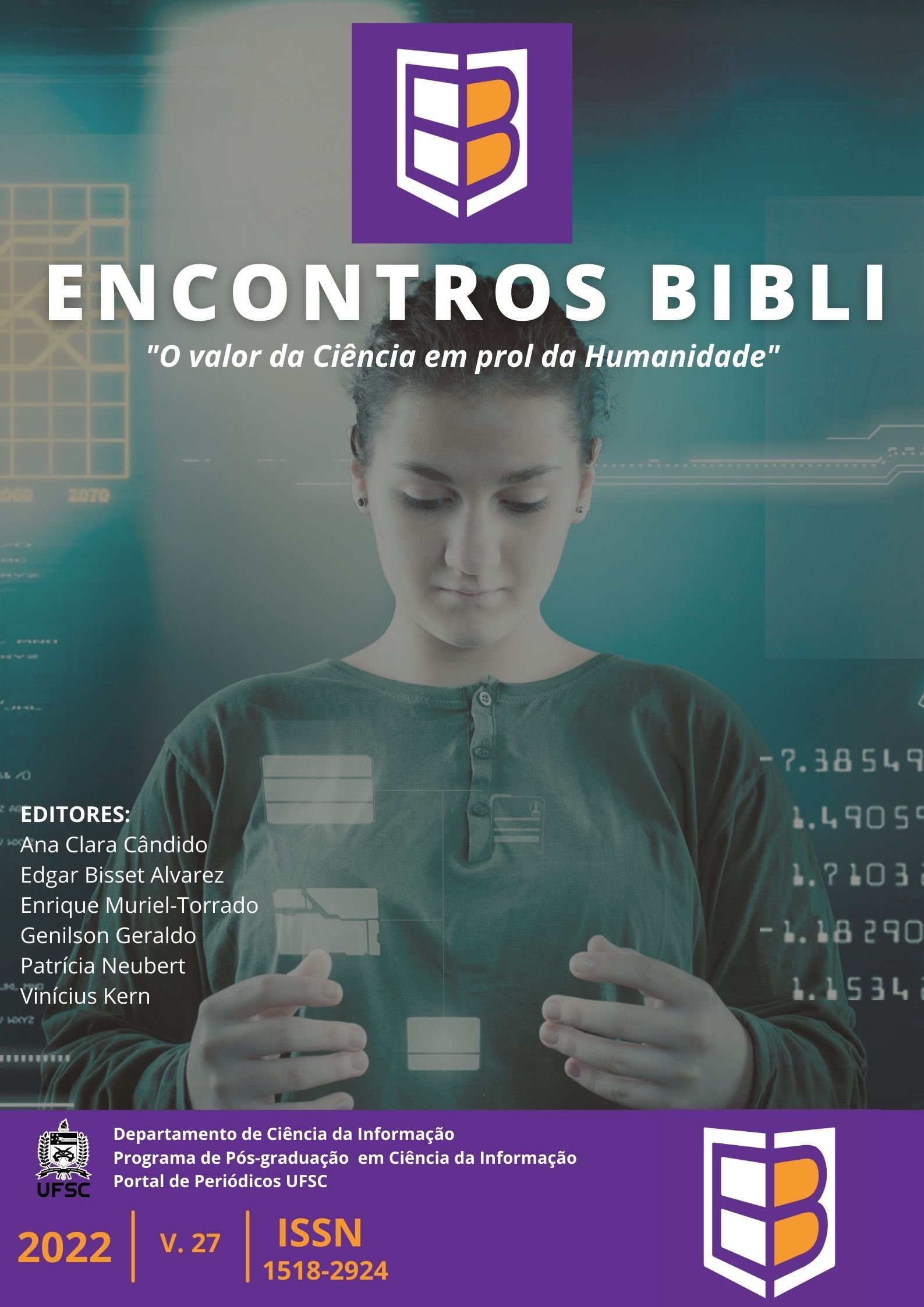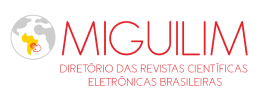Social curation: collective participation in the curation of digital-virtual museum environments
DOI:
https://doi.org/10.5007/1518-2924.2022.e84304Keywords:
Digital Curation, Information and Communication Technologies (ICT), Social Curation, Design Thinking, Participatory ApproachAbstract
Objective: The objective was to study a form of Digital Curation that contemplates social participation, that is, a curation model in which the community participates in its processes, and, consequently, feels represented, with a participatory, horizontal and inclusive approach.
Methods: The methodology is descriptive and exploratory, with a literature review and research on web environments and initiatives that disclose the practice of social curation.
Results: In the international context, some authors have addressed the social aspect of curation through the participatory approach. However, it was not possible to identify national authors who approach this perspective in the literature. The study observed that the Museu da Pessoa is pioneer in collaborative curation. International initiatives demonstrate the openness to participatory curation, transforming the community into cultural heritage curators.
Conclusions: Netizens have become co-curators of cultural memories in digital-virtual environments, and the curation can now count on the participation of the community in the reconstruction of the narratives of cultural heritage in hybrid environments. Participatory approach promotes equity in the relationship between the institution and society, democratizing access to transcultural heritage and enabling Social Curation.
Downloads
References
ATOM: Acess to Memory. Artefactual System, New Westminster, 2021. Available in: https://www.accesstomemory.org/pt-br/. Acess in: 10 jan. 2021.
ARCHIVEMATICA. Artefactual System, New Westminster, 2021. Available in: https://www.archivematica.org/pt-br/. Acess in: 10 jan. 2021.
BEAGRIE, N. The Digital Curation Centre. Learned Publishing, v. 17, n. 1, p. 7-9, 2004. Available in: https://onlinelibrary.wiley.com/doi/epdf/10.1087/095315104322710197. Acess in: 11 set. 2021.
CAGIGAL, P. Los museos como mediadores de la memoria en la era digital: museums as mediators of memory in the digital age. Revista de arte contemporáneo, n. 3, p. 22-30, 2017. Available in: https://dialnet.unirioja.es/servlet/articulo?codigo=6038975. Acess in: 27 jan. 2021.
CIDOC. What is LIDO. Berlin, 2020. Available in: http://cidoc.mini.icom.museum/working-groups/lido/what-is-lido/. Acess in: 28 jan. 2021.
CONARQ. Diretrizes para a implementação de resitórios arquivísticos digitais confiáveis-RdC-Arq. Rio de Janeiro, 2015. Available in: http://www.conarq.gov.br/images/publicacoes_textos/diretrizes_rdc_arq.pdf. Acess in: 27 jan. 2021.
DCC. What is curator. Edinburgh, 2004. Available in: https://www.dcc.ac.uk/about/digital-curation. Acess in: 28 jan. 2021.
DSPACE. Lyrasis, Atlanta, 2021. Available in: https://duraspace.org/dspace/. Acess in: 10 jan. 2021.
DUBLIN CORE. Available in: https://dublincore.org/. Acess in: 20 jan. 2021.
EAD. Development of the encoded archival description DTD. Library of Congress, 2013. Available in: https://www.loc.gov/ead/eaddev.html. Acess in: 20 jan. 2021.
FONTOURA, R. Colares que bipam e bastões coloridos e o novo normal nos museus. Brasília: ANESP, 2020. Available in: http://anesp.org.br/todas-as-noticias/2020/6/11/colares-que-bipam-e-bastes-coloridos-e-o-novo-normal-nos-museus. Acess in: 06 jan. 2021.
GIL, A. C. Métodos e técnicas da pesquisa social. 6. ed. São Paulo: Atlas, 2008. Available in: https://ayanrafael.files.wordpress.com/2011/08/gil-a-c-mc3a9todos-e-tc3a9cnicas-de-pesquisa-social.pdf. Acess in: 15 jan. 2021.
HIGGINS, S. Draft DCC Curation Lifecycle Model. The International Journal of Digital Curation, v. 2, n. 2, p. 82-87, 2007. Available in: http://www.ijdc.net/article/view/46/30. Acess in: 31 mai. 2022.
HIGGINS, S. The DCC curation lifecycle model. The International Journal of Digital Curation, v. 3, n. 1, p. 134-140, 2008. Available in: http://www.ijdc.net/article/download/69/48/0. Acess in: 20 jan. 2021.
HIGGINS, S. Digital Curation: the emergence of a new discipline. The International Journal of Digital Curation, v. 6, n. 2, p. 78-88, 2011. Available in: http://www.ijdc.net/article/view/184/251. Acess in: 20 jan. 2021.
ICOM. How to reach – and engage – your public remotely. Paris, 2020. Available in: https://icom.museum/en/news/how-to-reach-and-engage-your-public-remotely/. Acess in: 05 jan. 2021.
KAHN, K. O papel do Design da Informação na curadoria digital de sistemas memoriais: um estudo do Museu da Pessoa. 169 f. Dissertação (Mestrado em Ciência da Informação) – Universidade Estadual Paulista (Unesp), Faculdade de Filosofia e Ciências, Marília, 2018. Available in: https://repositorio.unesp.br/handle/11449/153993. Acess in: 23 jun. 2022
LAMPERT, S. R. Os repositórios DSpace e archivematica para documentos arquivísticos digi-tais. Acervo, Rio de Janeiro, v. 29, n. 2, p. 143-154, jul./dez. 2016. Available in: http://www.arquivistica.fci.unb.br/acervo-revista-do-arquivo-nacional/os-repositorios-dspace-e-archivematica-para-documentos-arquivisticos-digitais/. Acess in: 28 jan. 2021.
LONGO, E. The ultimate guide to virtual museum resources, e-learning, and online collections. Blog Advancing Digital Transformation in Museums, Nova York, 2020. Available in: https://mcn.edu/a-guide-to-virtual-museum-resources/. Acess in: 05 jan. 2021.
LORD, P.; MACDONALD, A. E-Science curation report: Data curation for e-science in the UK: an audit to establish requirements for future curation and provision. Reino Unido: The JISC Committee for the Support of Research, 2017.
MARC 21: Conteúdo. Divisão de Bibliotecas e Documentação da Pontifícia Universidade Católica do Rio de Janeiro, 2008. Available: https://www.dbd.pucrio.br/MARC21/conteudo.html. Acess in: 20 jan. 2021.
MEEHAN, N. Digital museum objects and memory: postdigital materiality, aura and value. Curator: The Museum Journal, v. 23, n. 1, 2020. Available in: https://onlinelibrary.wiley.com/toc/21516952/0/0. Acess in: 27 jan. 2021.
METS: metadata encoding & trasnmission standards. Library of Congress, 2021. Available in: https://www.loc.gov/standards/mets/. Acess in: 27 jan. 2021.
MINAYO, M. C. S.; SANCHES, O. Quantitativo-qualitativo: oposição ou complementaridade? Cad. Saúde Públ., v. 9, n. 3, 239-262. Available in: https://www.scielo.br/j/csp/a/Bgpmz7T7cNv8K9Hg4J9fJDb/?lang=pt&format=pdf. Acess in: 20 jan. 2021.
MUSEU DA PESSOA. Vidas indígenas. São Paulo, 2020. Available in: https://benfeitoria.com/vidasindigenas. Acess in: 10 jan. 2021.
NEMO. Survey on the impact of the COVID-19 situation on museums in Europe Final Report. Berlin, 2020. Available in: https://www.ne-mo.org/fileadmin/Dateien/public/NEMO_documents/NEMO_COVID19_Report_12.05.202. Acess in: 10 jan. 2021.
NHA. Transcribe the colletions. Nantucket, 2020. Available in: https://nha.org/research/the-collections/transcribe-the-collections/. Acess in: 10 jan. 2021.
NHA. Activity Stream. Nantucket, 2020. Available in: https://fromthepage.com/sma-archives/city-of-seattle-records. Acess in: 15 jan. 2021.
NORTH CAROLINA MUSEUM OF ART. North Carolina, 2021. Available in: https://ncartmuseum.org/calendar/series_parent/ncma_from_home. Acess in: 20 jan. 2021.
OAIS: Reference model for an open archival information system. Washington: Magenta Book, 2012. Available in: https://public.ccsds.org/Pubs/650x0m2.pdf. Acess in: 20 jan. 2021.
POPPLE, S.; MUTIBWA, D. H. Tools you can trust? co-design in community heritage work. In: BOROWIECKI, Karol Jan; FORBES, Neil; FRESA, Antonella (eds.). Cultural heritage in a changing world. Switzerland: Springer, 2016.
PREMIS. Preservation metadata maintenance activity. Library of Congress, 2021. Available in: https://www.loc.gov/standards/premis/. Acess in: 20 jan. 2021.
RIOS PEREZ, S. de los, et al. Technologies lead to adaptability and lifelong engagement with culture throughout the cloud. In: BOROWIECKI, Karol Jan; FORBES, Neil; FRESA, Antonella (eds.). Cultural heritage in a changing world. Switzerland: Springer, 2016.
RODA. Available in: https://www.roda-community.org/#welcome. Acess in: 12 jan. 2021.
SABHARWAL, A. Digital curation in the digital humanities: preserving and promoting archival and special collections. Waltham: Elsevier, 2015.
SAYÃO, L. F. Uma outra face dos metadados: informações para a gestão da preservação digital. Encontros Bibli: revista eletrônica de biblioteconomia e ciência da informação, vol. 15, n. 30, 2010, pp. 1-31. Available in: https://periodicos.ufsc.br/index.php/eb/article/view/1518-2924.2010v15n30p1. Acess in: 20 jan. 2021.
SCHILLING, S. Change of museums by change of perspective: reflecting experiences of museum development in the context of “EuroVision—Museums Exhibiting Europe” (EU Culture Programme). In: BOROWIECKI, Karol Jan; FORBES, Neil; FRESA, Antonella (eds.). Cultural heritage in a changing world. Switzerland: Springer, 2016.
SIMON, N. The participatory museum. California: Museum 20, 2010. Available in: https://tomskmuseum.ru/content/editor/Posetitel/Opit%20kolleg/Muzej-v-kontekste-kultury-uchastiya.pdf. Access in: 05 jan. 2021.
TRANT, J. Exploring the potential for social tagging and folksonomy in art museums: proof of concept. New Review of Hypermedia and Multimedia, 2006. Available in: https://www.researchgate.net/publication/220590177_Exploring_the_potential_for_social_tagging_and_folksonomy_in_art_museums_Proof_of_concept. Access in: 23 jun. 2022.
UNESCO. Museums around the world: in the face of COVID-19. Unesco Report. Paris, 2020. Available in: https://en.unesco.org/news/launch-unesco-report-museums-around-world-face-covid-19. Access in: 05 jan. 2021.
ZUANNI, C. Digital responses from locked-down museums. Cultural Practices, Reino Unido. Available in: https://culturalpractice.org/digital-responses-from-locked-down-museums/. Access in: 05 jan. 2021.
YARN Community. 2015. Available in: http://yarncommunity.com/. Acess in: 20 jan. 2021.
Published
How to Cite
Issue
Section
License
Copyright (c) 2022 Lucineia Da Silva Batista, Mariana Cantisani Padua, Maria José Vicentini Jorente

This work is licensed under a Creative Commons Attribution 4.0 International License.
The author must guarantee that:
- there is full consensus among all the coauthors in approving the final version of the document and its submission for publication.
- the work is original, and when the work and/or words from other people were used, they were properly acknowledged.
Plagiarism in all of its forms constitutes an unethical publication behavior and is unacceptable. Encontros Bibli has the right to use software or any other method of plagiarism detection.
All manuscripts submitted to Encontros Bibli go through plagiarism and self-plagiarism identification. Plagiarism identified during the evaluation process will result in the filing of the submission. In case plagiarism is identified in a manuscript published in the journal, the Editor-in-Chief will conduct a preliminary investigation and, if necessary, will make a retraction.
This journal, following the recommendations of the Open Source movement, provides full open access to its content. By doing this, the authors keep all of their rights allowing Encontros Bibli to publish and make its articles available to the whole community.
Encontros Bibli content is licensed under a Creative Commons Attribution 4.0 International License.
Any user has the right to:
- Share - copy, download, print or redistribute the material in any medium or format.
- Adapt - remix, transform and build upon the material for any purpose, even commercially.
According to the following terms:
- Attribution - You must give appropriate credit, provide a link to the license, and indicate if changes were made. You may do so in any reasonable manner, but not in any way that suggests the licensor endorses you or your use.
- No additional restrictions - You may not apply legal terms or technological measures that legally restrict others from doing anything that the license permits.

























